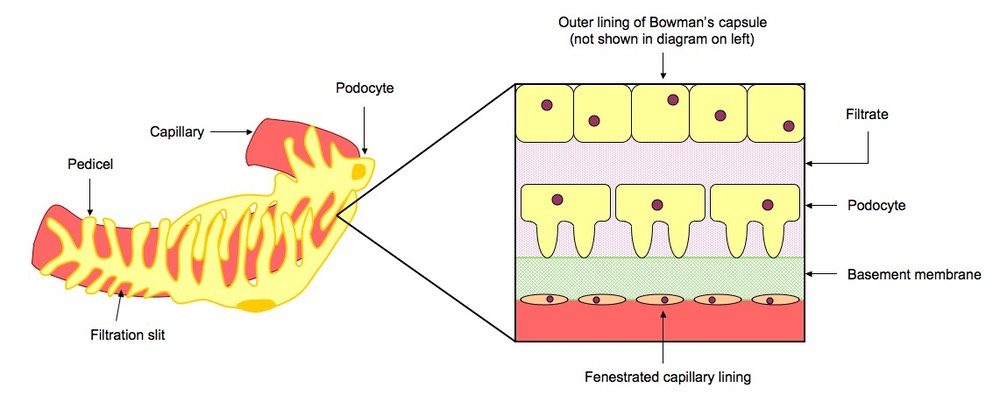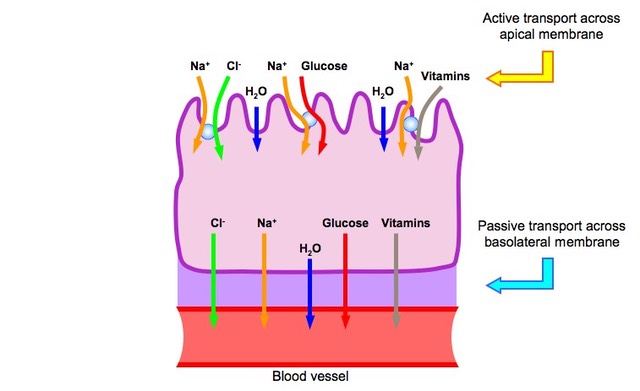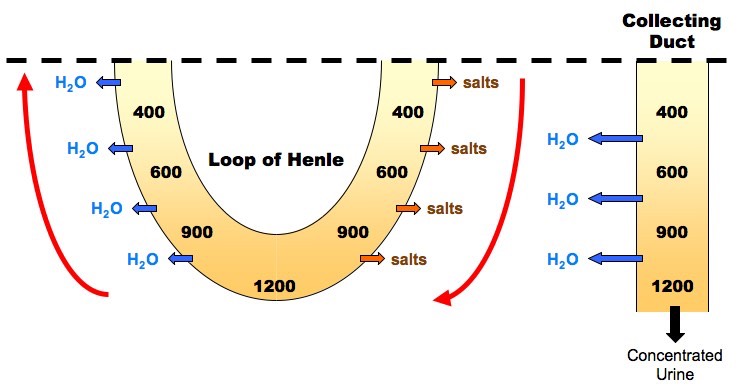11.3.1 Define excretion
Excretion is the removal from the body of the waste products of metabolic activities
11.3.2 Draw and label a diagram of the kidney
The Human Kidney

11.3.3 Annotate a diagram of a glomerulus and associated nephron to show the function of each part

The nephron is the functional unit of the kidney and includes:
Afferent arteriole: Brings blood to the nephron to be filtered
Efferent arteriole: Removes blood from nephron (minus filtered components)
Glomerulus: Capillary tuft where filtration occurs
Bowman's Capsule: First part of nephron where filtrate is collected
Proximal Convoluted Tubule: Where selective reabsorption occurs
Loop of Henle: Important for establishing a salt gradient in the medulla
Distal Convoluted Tubule: Final site of selective reabsorption
Collecting Duct: Feeds into ureter and is where osmoregulation occurs
Vasa Recta: Blood network that reabsorbs components from the filtrate
11.3.4 Explain the process of ultrafiltration, including blood pressure, fenestrated blood capillaries and basement membrane
- Ultrafiltration occurs when hydrostatic pressure forces blood through a semi-permeable membrane, separating blood cells and large proteins from the remainder of the serum
- Ultrafiltration occurs between the glomerulus and the Bowman's capsule and requires two things to form the filtrate:
Hydrostatic Pressure
- The glomerulus increases blood pressure by forming narrow branches (which also increases surface area for filtration)
- This pressure is maintained by a narrow efferent arteriole (relative to the afferent arteriole), which restricts the outflow of blood, keeping pressure high
- The net pressure gradient in the glomerulus forces blood into the capsule space
Basement Membrane
- The basement membrane is a fine mesh that restricts the passage of blood cells and proteins - it is the sole filtration barrier
- Blood can exit the glomerulus directly through pores as the capillaries are fenestrated
- The filtrate can enter the Bowman's capsule directly because the podocytes that surround the glomerulus contain filtration slits between their pedicels
- The basement membrane lies between the glomerulus and Bowman's capsule
Ultrafiltration

11.3.5 Define osmoregulation
Osmoregulation is the control of the water balance of the blood, tissue or cytoplasm of a living organism
11.3.6 Explain the reabsorption of glucose, water and salts in the proximal convoluted tubule, including the roles of microvilli, osmosis and active transport
- The proximal convoluted tubule extends from the Bowman's capsule and is where most selective reabsorption in the nephron occurs
- All glucose, amino acids, vitamins and hormones are reabsorbed here, along with most (~80%) of the mineral ions and water
- The proximal convoluted tubule has a microvilli cell lining to increase the surface area for the absorption of materials from the filtrate
- There are also a large number of mitochondria in these cells, as reabsorption from the filtrate involves active transport
- Once materials have been activly reabsorbed into the tubule cells, they can passively diffuse into the bloodstream (along the concentration gradient)
- Mineral ions and vitamins are actively transported via protein pumps or carrier proteins
- Glucose is actively transported across the membrane in symport with sodium
- Water follows the movement of the ions passively (via osmosis)
Selective Reabsorption in the Proximal Convoluted Tubule

11.3.7 Explain the roles of the loop of Henle, medulla, collecting duct and ADH (vasopressin) in maintaining the water balance of the blood
Creating a Salt Gradient in the Medulla
- The function of the loop of Henle is to create a salt bath concentration in the fluid surrounding the tubule
- The descending limb of the loop of Henle is permeable to water, but impermeable to salts
- The ascending limb of the loop of Henle is permeable to salts, but impermeable to water
- This means that as the loop descends into the medulla, the interstitial fluid becomes more salty (and less salty as it ascends into the cortex)
- As the vasa recta blood network that surrounds the loop flows in the opposite direction (counter-current exchange), this further multiplies the effect
Osmoregulation
- As the collecting duct passes through the medulla as it drains into the ureter, the hypertonic solution of the deep medulla will draw water by osmosis
- Antidiuretic hormone (ADH or vasopressin) is a hormone released from the posterior pituitary in response to dehydration (detected by hypothalamus)
- ADH increases the permeability of the collecting duct to water, allowing more water to be reabsorbed by osmosis (via the production of aquaporins)
- This means less water remains in the filtrate and the urine becomes more concentrated
- When the individual is suitably rehydrated, ADH levels will decrease and less water will be reabsorbed from the collecting ducts
Osmoregulation in the Medulla

11.3.8 Explain the difference in the concentration of proteins, glucose and urea between blood plasma, glomerular filtrate and urine
Proteins:
- Proteins will be present in blood plasma, but not present in glomerular filtrate or urine
- This is because proteins cannot pass across the basement membrane during ultrafiltration and thus cannot form part of the filtrate
Glucose:
- Glucose will be present in blood plasma and glomerular filtrate, but not present in urine (normally)
- This is because the glucose is selectively reabsorbed in the proximal convoluted tubule
- It is reabsorbed from the filtrate into the blood by active transport (symport with Na+ ions)
Urea:
- Urea will be present in blood plasma, glomerular filtrate and urine
- Only about 50% of urea is reabsorbed (some urea is reabsorbed to help regulate the medullary osmolarity gradient)
- Because water is reabsorbed from the filtrate (by osmosis, due to the hypertonicity of the medulla), urea becomes more concentrated in urine
- The concentration of urea in the urine will depend on the amount of water in the urine
11.3.9 Explain the presence of glucose in the urine of untreated diabetic patients
- The urine of non-diabetic patients should contain no glucose as it is selectively reabsorbed from the filtrate in the proximal convoluted tubule
- Diabetics have higher levels of blood glucose due to either a lack of insulin secretion (type I) or insensitivity to insulin secretions (type II)
- Because of this, not all of the glucose in diabetics is reabsorbed into the blood (protein pumps in tubule wall become saturated)
- This results in the presence of glucose in the urine of untreated diabetics, which can be detected using test strips